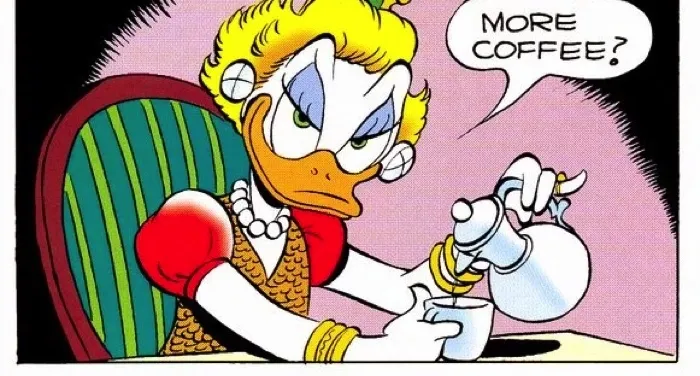
Back to “Back to the Klondike”: The 70 Year Saga of Scrooge McDuck’s Lost Love
If you grew up on comics in the 1950s or cartoons in the 1980s (or the 2010s), you’re probably familiar with Scrooge McDuck. Donald Duck’s fantastically wealthy but ridiculously miserly uncle is one of the most beloved pantsless cartoon animals of all time. He’s also globally beloved, thanks to the thriving Disney comics industry around the world. (Donald’s weekly magazine sells higher in tiny Finland than Batman or Spider-Man does in the States.)
You may not know about Scrooge’s romantic history, however. But 70 years ago this month, readers were introduced to the thwarted love story in Scrooge’s past. So let’s mark the occasion by going back to “Back to the Klondike!”
“Back to the Klondike” first appeared in Four Color #456 and was written and drawn by Carl Barks, the undisputed master of Duck comics. From the early ’40s through the late ’60s, Barks drew about 500 stories for Disney. Along the way, Barks created much of Donald’s key supporting cast, including Gyro Gearloose, Flintheart Glomgold, the Beagle Boys, Magica De Spell…and most importantly, Scrooge McDuck.
Though uncredited for much of his career and known only to contemporary fans as “the good Duck artist,” Barks’s importance to both Disney and comics as a medium is hard to overstate. His work inspired not just two separate DuckTales shows, but creators across a range of media. You know the giant stone ball deathtrap in Raiders of the Lost Arc? Yeah, Spielberg and Lucas — both Barks fans — lifted that from an Uncle Scrooge comic.
Scrooge debuted in 1947’s “Christmas on Bear Mountain” as a fairly one-note skinflint, but over the next few years, Barks refined his creation, adding in his adventurous spirit as well as the occasional grudging glimpse at his softer side. And 1953’s “Back to the Klondike” is a shining example of both.
The story begins in a fairly roundabout way, with Scrooge experiencing some serious memory issues, and, after Donald bullies him into seeing the doctor, being diagnosed with “blinkus of the thinkus,” a mild form of amnesia. He’s prescribed pills that improve his memory so much, he suddenly remembers a cache of gold he buried during the Yukon gold rush 50 years prior.
He also remembers a girl:
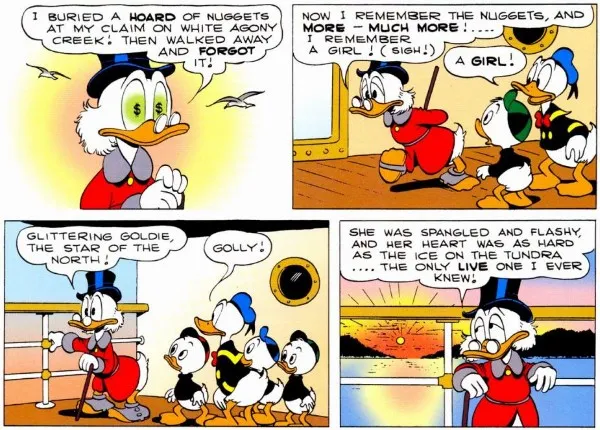
Scrooge rushes off to the Klondike to retrieve his gold, with Donald, Huey, Dewey, and Louie in tow, only to learn that his old cabin is occupied by a fierce old lady with a shotgun and a ferocious pet bear. After many pages of mishaps, the boys sneak into the cabin and discover that the old lady is none other than Glittering Goldie, in sadly reduced circumstances ever since the gold rush ended.
Despite being clearly still smitten with her, Scrooge insists that she owes him an astronomical sum, and he’s here to collect. Her head held high, Goldie scornfully hands over the last of her jewelry and the deed to her claim and marches off to the poorhouse, proud to the last.
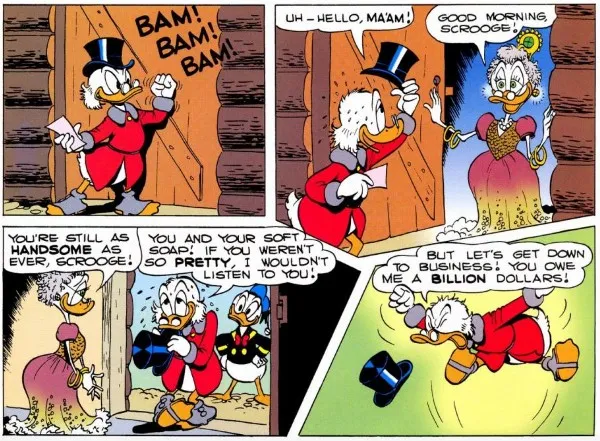
Shockingly, Scrooge suffers a sudden pang of conscience, and challenges Goldie to a contest: she always said she could dig more gold than he could, so if she can prove it, she can keep the claim, plus any gold she finds. He directs her to an unlikely spot…and wouldn’t you know it, she promptly uncovers the very cache he came back to the Klondike to retrieve!
Scrooge promptly throws a loud tantrum, lamenting his failure to take his memory pills, but Donald knows better. He’s been keeping track, and there’s one less pill this morning than there was last night, meaning Scrooge rigged the contest to lose. As the Nephews put it: “Good old Unca Scrooge!”
It’s a charming story and shows all of the characters at their very best: Scrooge softer than we’ve ever seen him before, Donald at his most nurturing and emotionally intelligent, the Nephews at their most resourceful. Goldie doesn’t get a ton of page time, but she’s tough as nails and dignified to the end. It’s not a surprise that it was reprinted multiple times.
But as originally published, something seems to be missing. Why does Goldie owe Scrooge a thousand dollars? What exactly happened between them back in the day?
The truth is too salacious for Disney — or at least, it was in 1953. See, a four page flashback was cut from Barks’s original story for the first printing. In those pages, a young and cocky Scrooge swaggers into Goldie’s dance hall with a gold nugget the size of a goose egg. Goldie promptly offers him a drugged cup of coffee, and Scrooge wakes up in the snow outside to discover he’s been robbed. He storms back into the dance hall, beats up at least 19 men in one gloriously over-the-top panel, drags Goldie off to his claim, and forces her to work there for a month so that she sees how hard a life miners have. When he pays her a paltry $0.50 cents a day for her labor, she throws it in his face and storms off.
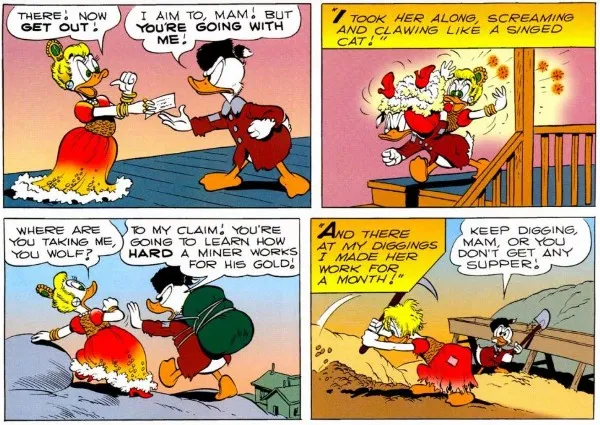
Drugs! Barroom brawls! Abduction! Ducks living in sin! It’s no wonder that Disney looked at this story and went “Carl. No.” Especially a year before Seduction of the Innocent and the formation of the Comics Code Authority, when pearl-clutching over inappropriate material in comics was at its height.
Personally, as admittedly problematic as it is, I find the saucier version of the story even more fun than the already excellent Bowdlerized one. I’m not alone in that. Don Rosa, the Duck artist who is widely considered the successor to Barks’s crown, gleefully expanded on that four-page flashback in his The Life and Times of Scrooge McDuck Companion, playing up both the doomed romance and the sexual tension. There’s even an unsubtle fade-to-black scene. Yes, with cartoon ducks. Trust me, it works in context.
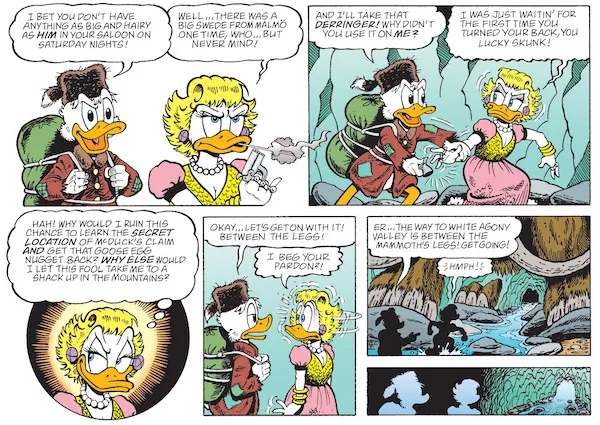
Both versions of DuckTales have used Goldie. The 1987 show stuck with a fairly faithful adaptation of “Back to the Klondike,” with Goldie voiced by Joan Gerber. The 2017 version of DuckTales took more liberties with the character, using her multiple times as a foil for Scrooge — just as clever, brave, and adventurous as him, but also an unrepentant con artist. Voiced by the great Allison Janney, this version of Goldie retains all of her grit and sass, but she also gets to be in on the action, instead of sitting around for 50 years in increasing poverty, waiting for Scrooge.
Barks’s stories are products of their time and as such frequently problematic, but they also retain an enduring appeal. “Back to the Klondike,” with its early hint at Scrooge’s vulnerabilities and Goldie in all of her fierce, spangled-and-flashy glory, is a great example of why. I hope Duck artists continue to use her, and I hope she keeps making it into adaptations for at least the next 70 years. Happy birthday, Goldie!
Want to read more Duck comics? “Back to the Klondike” is collected in Only a Poor Old Man, part of Fantagraphics’s gorgeous Complete Carl Barks Library series. Or check out this article for other places to start with the Ducks!










